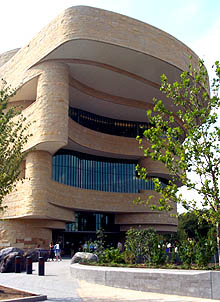By Lee Rosenbaum
The effect of these stereotype-busting displays is sometimes jarring, especially because the canon now includes contemporary art. Today's curators want visitors to view Indian artworks not as quaint ethnographic artifacts, but as vital expressions of a living culture, spanning prehistory to the present.
Curated by Cécile Ganteaume, with multimedia commentary by tribe members and scholars, "Infinity of Nations" takes visitors on an in-depth journey from South America to the Arctic, with engagingly presented information about objects, cultures, individual artists and historical figures. It ends with a contemporary section featuring 18 artists. Washington's NMAI also accords prominence to contemporary art in curator Rebecca Head Trautmann's wide-ranging, thematically organized "Vantage Point" show (to Aug. 7), displaying 31 works it acquired over the past seven years.
For the first time, he disclosed plans for a complete reinstallation of the Washington museum, beginning in 2014. The new approach he described may deflect the harshest attack directed at the inaugural displays by some American Indians—that the depredations and atrocities suffered by indigenous people at the hands of white invaders were soft-pedaled. New displays will likely focus on several provocative themes, according to Mr. Gover, a lawyer with scant background in art or museums. Among them: the devastation of the indigenous population "on the order of 90% to 95%"; the role of contact with Europeans as "the definitional event that shaped the modern world."
References to "massacre" and "genocide" may be included, if deemed appropriate by the curators, said Mr. Gover, who succeeded director W. Richard West Jr. three years ago. "You don't have an American Indian museum without discussion of dispossession and death on a scale unknown in human history," he declared.
This approach may put the Washington museum even more at odds with those art lovers who found the inaugural installation too political and polemical. And it would move the museum even further from its origins as a showcase for the trove assembled by Heye.
Perhaps more critically, it is not certain how a heightened focus on injustice and grievances will be viewed by the amateur art critics who meet just down the road—members of Congress who oversee the Smithsonian and currently appropriate some 60% of the NMAI's operating budget.
"I don't think it is controversial," Mr. Gover said of his new approach. "Two years ago, Congress passed an apology resolution. . . . I think the country has never been more ready for this."
I agree with the critics, so I support the "complete reinstallation" of the NMAI's exhibits. I think they should talk about massacres and genocide and even (gasp!) use those words. You don't have to hit people over the heads with these subjects, but to ignore them isn't good either.
True, conservative politicians won't like this approach. They've proved they can't handle the truth about America's history. Liberals may have to fight for the NMAI, but if I were in charge, I'd do it. It's long past time for Americans to deal with their ancestors' crimes against Indians.
For more on the subject, see Rothstein: Ethnic Stories Cry "Me"! and NMAI = Greatest Story Never Told.


No comments:
Post a Comment
Note: Only a member of this blog may post a comment.